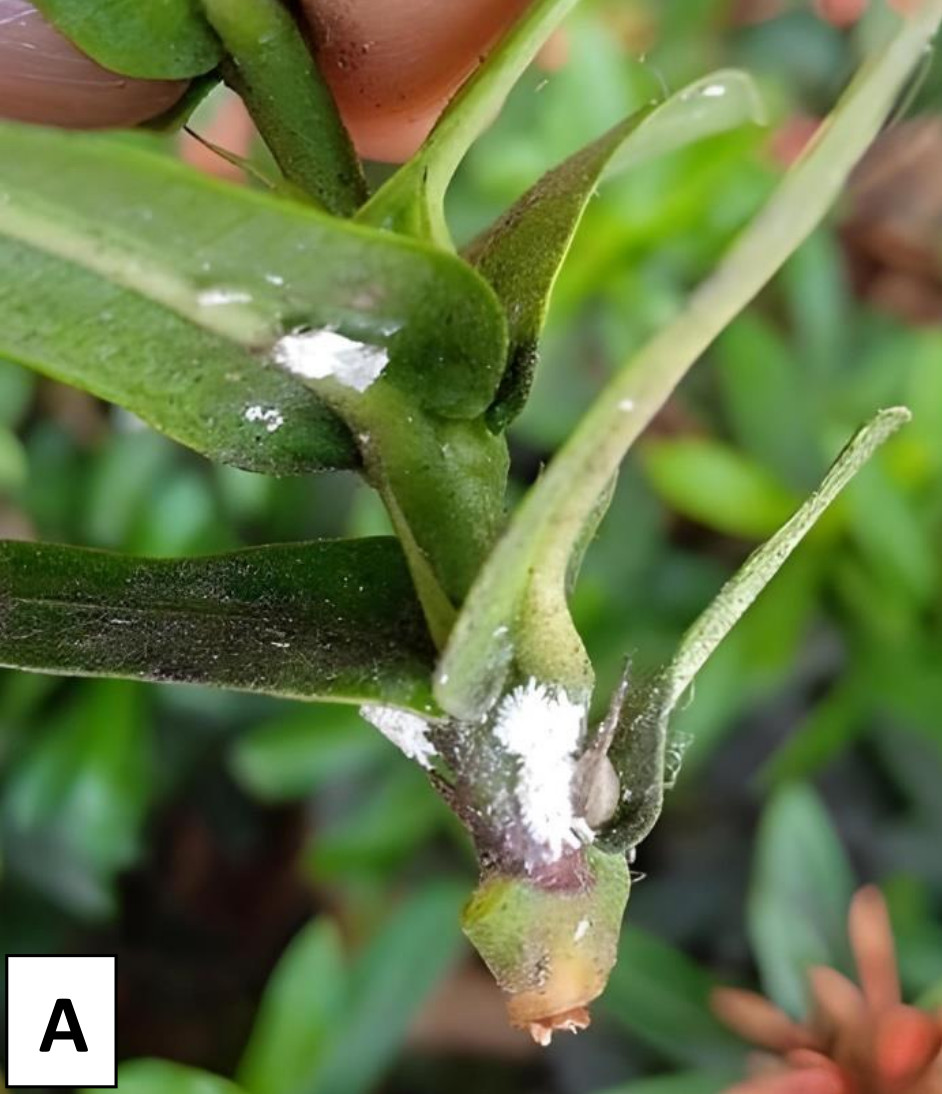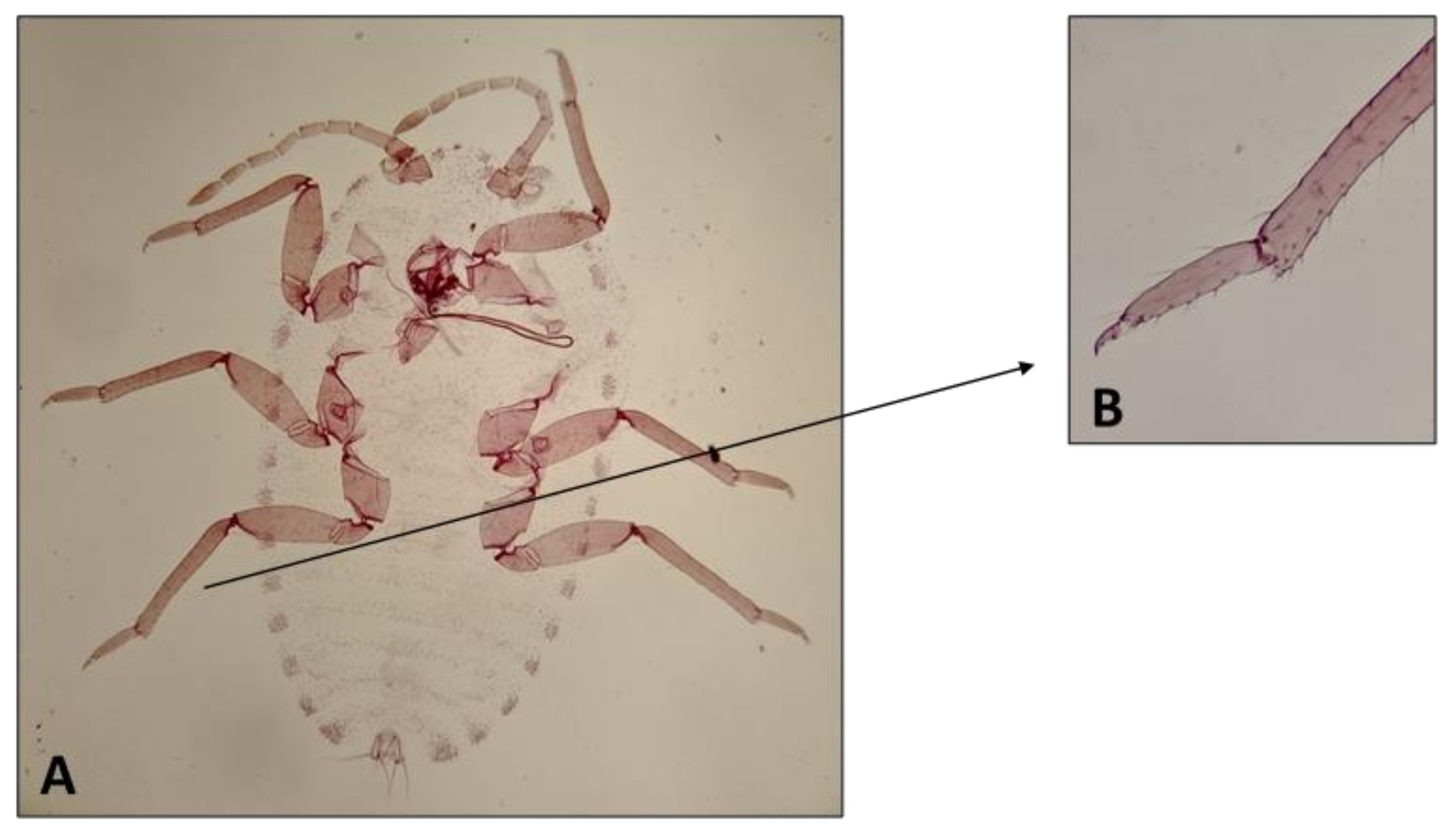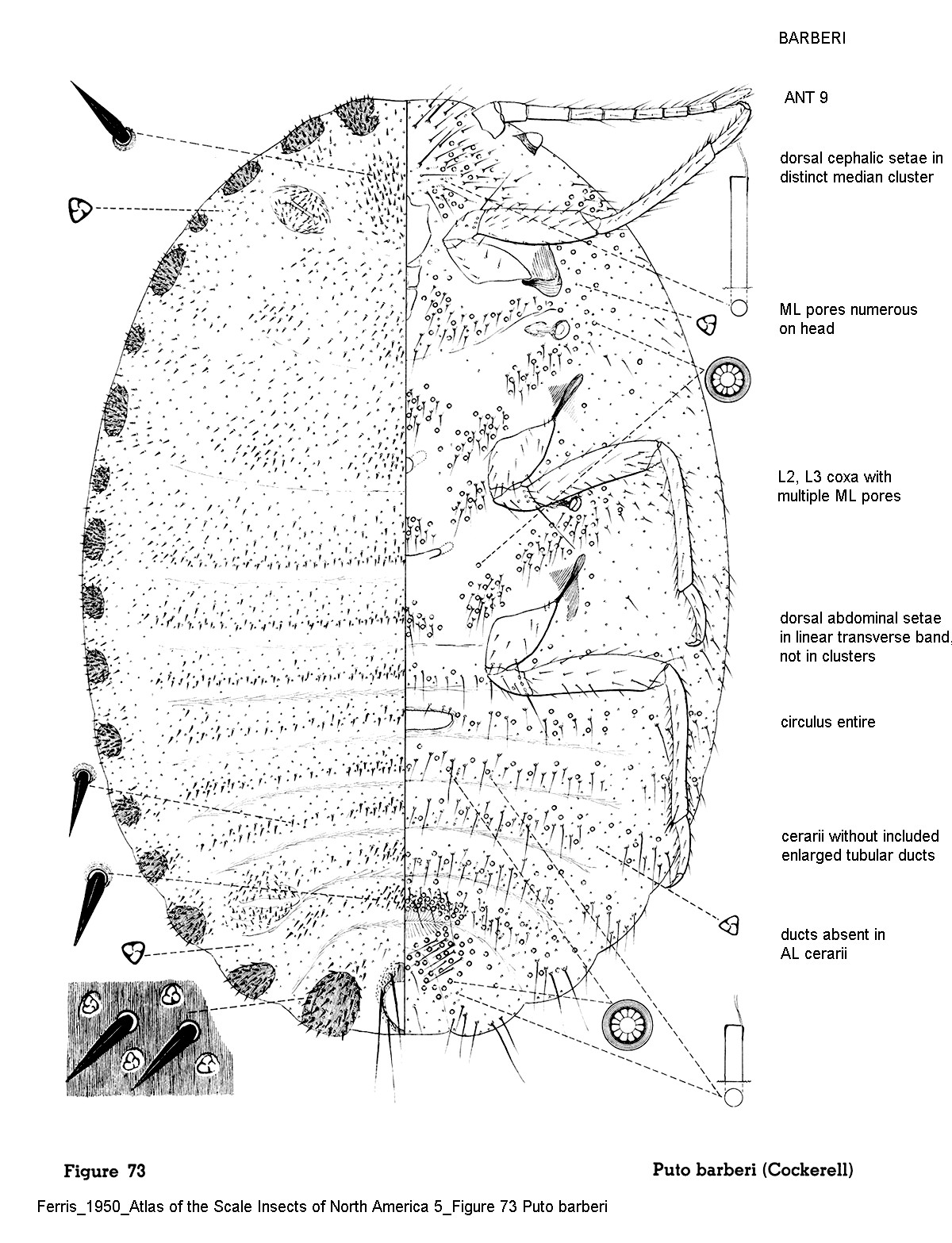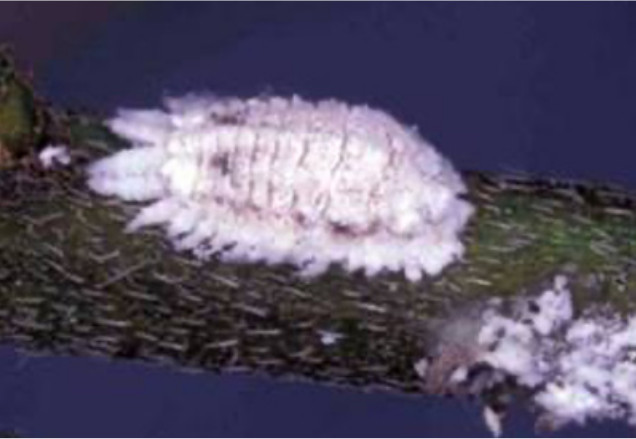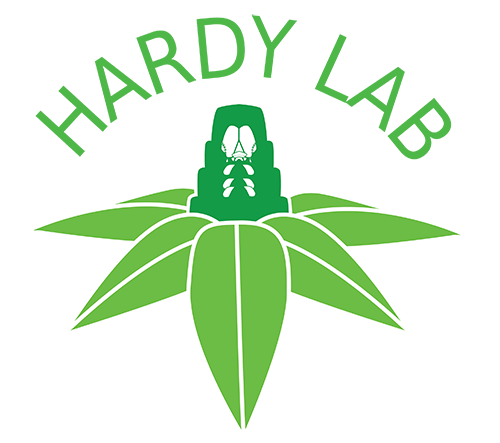Valid Names Results
Puto barberi (Cockerell, 1895) (Putoidae: Puto)Nomenclatural History
- Phenacoccus yuccae barberi Cockerell 1895q: 61. Type data: ANTIGUA: on Allamanda [= Allemanda], Thunbergia grandiflora, Coleus and Croton. Syntypes, female, Type depository: Washington: United States National Entomological Collection, U.S. National Museum of Natural History, District of Columbia, USA; accepted valid name
- Phenacoccus yuccae barberi; Cockerell 1896f: 39. subsequent use Notes: Author incorrectly cited.
- Ceroputo barberi (Cockerell, 1895); Cockerell 1901j: 166. change of combination and rank
- Phenacoccus trinidadensis Laing 1925: 52. Type data: TRINIDAD: Toco Beach, on Coccoloba uvifera. Holotype, female, Type depository: London: The Natural History Museum, England, UK; junior synonym (discovered by Laing1929a, 475).
- Puto barberi (Cockerell, 1895); Ferris 1950b: 197. change of combination
- Puto baberi (Cockerell, 1895); Mora, et al. 2018: 21. misspelling of species epithet
Common Names
- Barber’s giant mealybug Kondo2022a
- Cochinilla blanca de la raíz Kondo2022a
- cochinilla de la raíz del cafeto Kondo2022a
- cochinilla gigante Kondo2022a
- cochinilla gigante de Barber Kondo2022a
Ecological Associates
Hosts:
Families: 34 | Genera: 50
- Acanthaceae
- Thunbergia | KondoRaVe2008
- Thunbergia grandiflora | BenDov1994
- Amaranthaceae
- Amaranthus dubius | MoraRaBa2018
- Apiaceae
- Daucus carota | BenDov1994 WilliaGr1992
- Apocynaceae
- Allamanda | BenDov1994 Cocker1895q
- Asclepias curassavica | MoraRaBa2018
- Araliaceae
- Schefflera | KondoRaVe2008
- Asteraceae
- Bidens pilosa | MoraRaBa2018
- Mikania micrantha | BenDov1994 WilliaGr1992
- Sigesbeckia jorullensis | MoraRaBa2018
- Berberidaceae
- Nandina domestica | KondoRaVe2008
- Bignoniaceae
- Spathodea campanulata | KondoRaVe2008
- Bromeliaceae
- Bromeliaceae | BenDov1994 WilliaGr1992
- Caprifoliaceae
- Lonicera japonica | BenDov1994 WilliaGr1992
- Caryophyllaceae
- Dianthus | BenDov1994 WilliaGr1992
- Commelinaceae
- Commelina diffusa | MoraRaBa2018
- Cycadaceae
- Cycadaceae | KondoRaVe2008
- Cyperaceae
- Cyperus luzulae | MoraRaBa2018
- Cyperus obesus | MoraRaBa2018 | (= Cyperus flavus)
- Cyperus odoratus | MoraRaBa2018 | (= Cyperus ferax)
- Dryopteridaceae
- Elaphoglossum latifolium | BenDov1994 WilliaGr1992
- Euphorbiaceae
- Acalypha | BenDov1994 WilliaGr1992
- Acalypha wilkesiana | BenDov1994 Bennet1957 FoldiKo2006 WilliaGr1992
- Croton | BenDov1994 Cocker1895q WilliaGr1992
- Manihot esculenta | BenDov1994 WilliaGr1992
- Fabaceae
- Bauhinia purpurea | KondoRaVe2008
- Cajanus | BenDov1994 WilliaGr1992
- Gliricidia sepium | BenDov1994 Bennet1957
- Geraniaceae
- Geranium | BenDov1994 WilliaGr1992
- Lamiaceae
- Coleus | BenDov1994 Cocker1895q
- Lauraceae
- Persea americana | BenDov1994 WilliaGr1992
- Lythraceae
- Cuphea racemosa | BenDov1994 WilliaGr1992
- Malvaceae
- Hibiscus | BenDov1994 WilliaGr1992
- Hibiscus rosa-sinensis | KondoRaVe2008
- Theobroma cacao | BenDov1994 WilliaGr1992
- Myrtaceae
- Psidium guajava | MatileEt2006
- Nyctaginaceae
- Bougainvillea glabra | BenDov1994 WilliaGr1992
- Oleaceae
- Oleaceae | BenDov1994 WilliaGr1992
- Plantaginaceae
- Plantago major | MoraRaBa2018
- Poaceae
- Cenchrus echinatus | MoraRaBa2018
- Cynodon dactylon | MoraRaBa2018
- Digitaria sanguinalis | MoraRaBa2018
- Elusine indica | MoraRaBa2018
- Paspalum notatum | MoraRaBa2018
- Polygonaceae
- Coccoloba uvifera | BenDov1994 Laing1925a WilliaGr1992
- Polygonum nepalense | MoraRaBa2018
- Rumex crispus | MoraRaBa2018
- Rosaceae
- Fragaria | BenDov1994 WilliaGr1992
- Rubiaceae
- Coffea | KondoRaVe2008
- Coffea arabica | BenDov1994 KondoRaVe2008 WilliaGr1992
- Ixora | JansenAl2023
- Ixora coccinea | MedinaNaMu2024
- Rutaceae
- Amyris pinnata | KondoRaVe2008
- Citrus | BenDov1994 WilliaGr1992
- Citrus aurantiifolia | BenDov1994 KondoRaVe2008 WilliaGr1992
- Citrus maxima | BenDov1994 WilliaGr1992
- Citrus nobilis | BenDov1994 WilliaGr1992 | var. major
- Citrus paradisi | MatileEt2006
- Swinglea glutinosa | KondoRaVe2008
- Solanaceae
- Physalis | BenDov1994 WilliaGr1992
- Solanum nigrum | MoraRaBa2018
- Tamaricaceae
- Tamarix | BenDov1994 WilliaGr1992
- Verbenaceae
- Lantana camara | BenDov1994 Bennet1957 WilliaGr1992
Foes:
Families: 2 | Genera: 4
- Encyrtidae
- Aenasius | MoraRaBa2018
- Aenasius bolowi | MoraRaBa2018
- Aenasius caeruleus | GilCoMa2023
- Hambletonia | MoraRaBa2018
- Hambletonia pseudococcina | GilCoMa2023
- Zarhopalus putophilus | GilCoMa2023
- Pseudococcidae
- Puto barberi | GilCoMa2023
Associates:
Families: 1 | Genera: 4
- Formicidae
- Acropyga | MoraRaBa2018
- Brachymyrmex | MoraRaBa2018
- Solenopsis | MoraRaBa2018
- Tranopelta | MoraRaBa2018
Geographic Distribution
Countries: 17
- Antigua and Barbuda
- Antigua | BenDov1994 Cocker1895q
- Bahamas | BenDov1994 WilliaGr1992
- Canary Islands | PellizPo2017
- Colombia | BenDov1994 DownieGu2004 KondoRaVe2008 WilliaGr1992
- Dominican Republic | BenDov1994 WilliaGr1992
- Ecuador | MedinaNaMu2024
- Grenada | BenDov1994 WilliaGr1992
- Guadeloupe | MatileEt2006
- Haiti | PerezG2008
- Jamaica | BenDov1994 WilliaGr1992
- Montserrat | BenDov1994 WilliaGr1992
- Puerto Rico & Vieques Island
- Puerto Rico | BenDov1994 WilliaGr1992
- Saint Kitts and Nevis Islands
- Saint Kitts | BenDov1994 Cocker1895q WilliaGr1992
- Saint Lucia | BenDov1994 WilliaGr1992
- Trinidad and Tobago
- Tobago | BenDov1994 WilliaGr1992
- Trinidad | BenDov1994 Bennet1957 Cocker1895q Laing1925a WilliaGr1992
- U.S. Virgin Islands | BenDov1994 WilliaGr1992
- Venezuela | BenDov1994 FoldiKo2006 WilliaGr1992
Keys
- ZhengLiTa2025: pp.134 ( Adult (F) ) [Puto from the Old World (updated from Danzig & Gavrilov 2014)]
- PowellMi2024: pp.303-304 ( Adult (F) ) [New World Puto species]
- CaballKo2024: pp.7 ( Adult (F) ) [Species associated with coffee roots in Colombia]
- WilliaGr1992: pp.469 ( Adult (F) ) [Central and South America]
- McKenz1967: pp.328 ( Adult (F) ) [U.S.A., California]
- McKenz1961: pp.33 ( Adult (F) ) [North America]
- McKenz1960: pp.731 ( Adult (F) ) [North America]
- Ferris1950b: pp.192 ( Adult (F) ) [North America]
Remarks
- Systematics: Giant mealybugs, Puto spp., superficially resemble mealybugs (Pseudococcidae) because the body surface is covered in mealy wax. Puto species are generally all very similar, so reliable identification depends on the study of morphological features seen only in slide-mounted adult females. (T. Kondo (2022a) in T. Kondo & G.W. Waton, 2022)
- Structure: In life, body elongate oval, fairly robust, conspicuously convex in lateral view, with a dense covering of mealy wax concealing body colour with the exception of two dark spots on posterior abdomen. With a dorsomedial crest of wax, a conspicuous marginal band of plate-like waxy filaments variable in number because often fused, surrounding entire body; posterior filaments in pairs, longer than rest of waxy filaments, and without an ovisac. Legs large, black or dark brown. (T. Kondo (2022a) in T. Kondo & G.W. Waton, 2022)
- Biology: This species is ovoviviparous and parthenogenic. It has two nymphal states and its life cycle is approximately 141 days at 25 degrees C.It changes from the nymph state to adult in 62 days
- Economic Importance: Puto barber, like many other scale insects, causes direct damage by sucking phloem sap from host plants. In Colombia, the roots of up to 86% of coffee trees were found to be infested by P. barberi. It is also commonly found on aerial parts of the plant, with heavy infestations resulting in defoliation and dieback of the hosts. (T. Kondo (2022a) in T. Kondo & G.W. Waton, 2022)
- General Remarks: Good description and illustration of the adult female given by Ferris (1950b) and by Williams & Granara de Willink (1992).
Illustrations
Citations
- AgredoMoPo2025: biological control, chemical control, chemistry, economic importance, illustration,
- BenDov1994: catalog, 419-420
- CaballKo2024: illustration, key, morphology, 6-7
- CaballRaGi2018: distribution, host, illustration,
- ChoiLe2022: endosymbiont, phylogeny, 358, 359
- Cocker1895q: description, distribution, host, taxonomy, 61
- Cocker1901j: taxonomy, 166
- DiazNiPiMe2023: biology, diagnosis, economic control, host, illustration, life cycle, male, morphology, 9, 29-30
- DownieGu2004: distribution, host, molecular data, phylogeny, 258-259
- Ferris1950b: description, distribution, host, illustration, taxonomy, 197-198
- FoldiKo2006: distribution, host, 311
- Gavril2018: reproduction, 226
- GavrilDa2015: distribution, 97
- GilCoMa2023: natural enemies, 2
- HardyGuHo2008: molecular data, phylogeny, taxonomy, 51-71
- JansenAl2023: dispersal, host, 31
- Kondo2001: distribution, host, taxonomy, 38
- Kondo2022a: biology, control, diagnosis, distribution, economic control, host, illustration, 115-116
- KondoMu2016: distribution, host, illustration, 12
- KondoRaVe2008: distribution, host, 46
- KondoWa2022a: distribution, host, list, 25
- KondoWa2022d: illustration, 549
- Laing1925a: description, distribution, host, illustration, taxonomy, 52
- Laing1929a: taxonomy, 475
- Malump2012b: distribution, 211
- Malump2014a: distribution, host, 82
- MatileEt2006: distribution, host, 183
- MedinaNaMu2024: distribution, host, illustration, record,
- Meurge2011: distribution, 82
- MoraRaBa2018: distribution, host,
- PellizPo2017: distribution, 108
- PerezG2008: distribution, 217
- PoornaSiMu2025: control, distribution, host, 15
- PowellMi2024: key, 303-304
- SagarrViSt2001a: biological control, 112-116
- SchneiLa2020: ant association, 288
- SilvaMeAn2025: bacteria, 3
- SuarezGiBe2018: distribution, host,
- Willia2017a: catalog, list of species, 251
- WilliaGr1992: description, distribution, host, illustration, taxonomy, 473-475
- ZhengLiTa2025: distribution, host, taxonomy, 119
